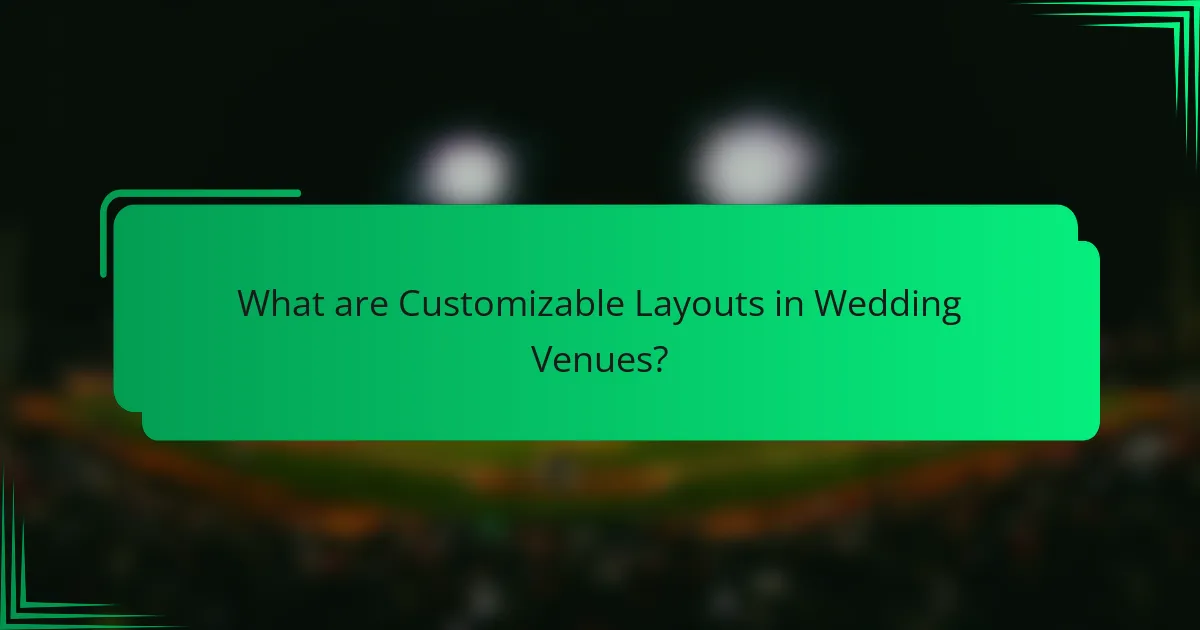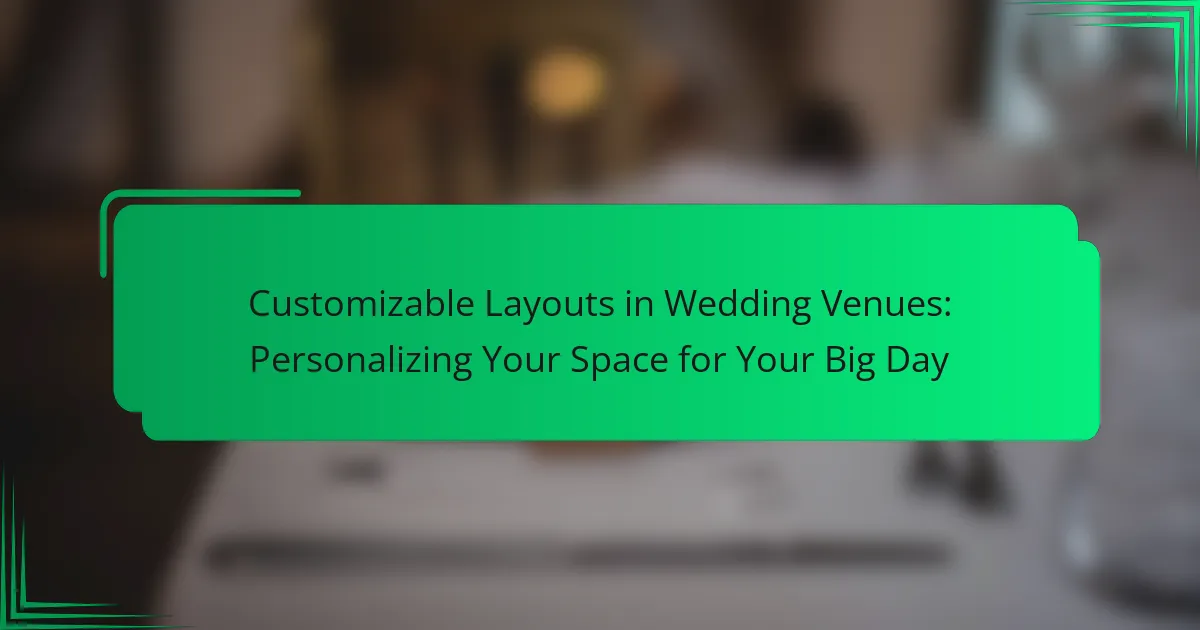Customizable layouts in wedding venues provide couples with the flexibility to design their event space according to personal preferences. This includes various options for seating arrangements, decor, and the overall flow of the event, allowing for traditional banquet styles, cocktail setups, or unique configurations. Many venues offer movable furniture and partitions to enhance guest experiences and accommodate different activities. Additionally, experienced staff are often available to assist with planning, ensuring that the chosen layout meets both aesthetic and functional needs for the wedding day. This level of customization allows couples to reflect their personal style and theme in their celebration.

What are Customizable Layouts in Wedding Venues?
Customizable layouts in wedding venues refer to flexible arrangements that allow couples to design their event space according to their preferences. This includes options for seating, decor, and overall flow of the event. Many venues offer movable furniture and partitions to facilitate various layouts. Couples can choose between traditional banquet styles, cocktail setups, or unique configurations. This flexibility enhances the guest experience by accommodating different activities throughout the event. Customizable layouts can also reflect the couple’s personal style and theme. Venues that provide these options often have experienced staff to assist with planning. This ensures that the layout meets both aesthetic and functional needs for the wedding day.
How do customizable layouts enhance the wedding experience?
Customizable layouts enhance the wedding experience by allowing couples to tailor the venue to their vision. This personalization creates a unique atmosphere that reflects their style and preferences. Couples can choose seating arrangements that foster interaction among guests. They can also select decor that complements their theme, enhancing the overall aesthetic. Customizable layouts can accommodate specific activities, such as dancing or dining, improving guest engagement. Research shows that personalized environments increase guest satisfaction, leading to memorable experiences. A study by the Journal of Consumer Research found that customization positively impacts emotional connections to events. This tailored approach ultimately contributes to a more enjoyable and meaningful celebration.
What key elements are involved in creating a customizable layout?
Key elements involved in creating a customizable layout include space planning, furniture arrangement, and decor selection. Space planning ensures that the layout accommodates guests comfortably. Furniture arrangement allows for flexible seating options and flow. Decor selection enhances the theme and ambiance of the venue. Additionally, lighting options can be adjusted to create different moods. Accessibility considerations are crucial for all guests. Technology integration, like sound systems, can enhance the experience. Each of these elements contributes to a personalized and functional layout for the event.
How do different layouts reflect personal style and preferences?
Different layouts in wedding venues reflect personal style and preferences through their arrangement and design choices. For instance, a traditional banquet layout with round tables may indicate a preference for classic elegance. In contrast, a more casual layout with lounge seating can showcase a relaxed, modern aesthetic.
Layouts can also influence the flow of the event. A linear setup can facilitate easy movement and interaction, appealing to those who value social engagement. On the other hand, a more segmented layout may cater to couples who prefer intimate settings.
The choice of layout often aligns with the couple’s vision for their wedding. Research shows that 70% of couples prioritize personalization in their venue choices. This personalization includes selecting layouts that resonate with their unique style, whether it be rustic, vintage, or contemporary.
Ultimately, the layout serves as a canvas for couples to express their individuality, making it a crucial aspect of wedding planning.
What types of customizable layouts are available for wedding venues?
Wedding venues offer various customizable layouts to suit different preferences. Common layouts include banquet style, theater style, and cocktail style. Banquet style features round tables for dining and socializing. Theater style arranges chairs in rows for presentations or ceremonies. Cocktail style promotes mingling with high-top tables and open space. Additionally, venues may offer outdoor and indoor options for flexibility. Some venues allow for unique arrangements like U-shape or hollow square setups. Customizable layouts enhance the overall wedding experience. They cater to guest interaction and the couple’s vision for their special day.
What are the most popular layout options for wedding receptions?
The most popular layout options for wedding receptions include banquet style, cocktail style, and theater style. Banquet style features round tables for guests, promoting conversation and a formal dining experience. Cocktail style encourages mingling with high-top tables and limited seating, ideal for a casual atmosphere. Theater style arranges chairs in rows, focusing on a central stage or area, often used for ceremonies or speeches. Each layout option caters to different themes and guest interactions, making them versatile choices for various wedding styles.
How can seating arrangements be tailored to fit various themes?
Seating arrangements can be tailored to fit various themes by selecting styles, layouts, and decor that reflect the desired atmosphere. For a rustic theme, wooden tables and mismatched chairs can enhance the natural feel. A formal theme may require elegant round tables with fine linens and chiavari chairs. For a beach theme, light colors and casual seating like lounge chairs create a relaxed vibe.
Incorporating centerpieces and table settings that align with the theme further personalizes the arrangement. For instance, floral arrangements can match a garden theme, while lanterns can suit a vintage theme. The arrangement’s layout can also be adjusted; for example, a theater-style setup works well for presentations, while a U-shape encourages interaction.
Ultimately, the choice of seating should resonate with the overall wedding style, ensuring a cohesive experience for guests.
Why is personalization important in wedding venue layouts?
Personalization is important in wedding venue layouts because it enhances the overall experience for the couple and guests. Customized layouts reflect the couple’s unique style and preferences. This connection fosters a more intimate atmosphere. Personalization can include specific seating arrangements, decor choices, and thematic elements. According to a survey by The Knot, 75% of couples prioritize personal touches in their wedding planning. These touches can make the event feel more meaningful and memorable. Ultimately, personalized layouts contribute to a cohesive and engaging celebration.
How does personalization impact guest experience?
Personalization significantly enhances guest experience by creating a unique and memorable atmosphere. Customized elements, such as decor and seating arrangements, reflect the couple’s personality and preferences. This tailored approach fosters emotional connections among guests. Research shows that 70% of consumers are more likely to engage with brands that offer personalized experiences. In wedding venues, personalization can lead to higher guest satisfaction and positive feedback. Personalized experiences also encourage guests to feel valued and appreciated. Ultimately, this contributes to a more enjoyable and engaging celebration.
What role does customization play in creating memorable moments?
Customization plays a crucial role in creating memorable moments by allowing individuals to tailor experiences to their personal preferences. Personalized elements enhance emotional connections to events. For example, customized décor can reflect a couple’s unique story. This can include specific color schemes or thematic elements that resonate with their journey. Research indicates that personalized experiences significantly increase satisfaction and emotional impact. A study by Pine and Gilmore in “The Experience Economy” highlights that tailored experiences lead to stronger memories. Ultimately, customization transforms ordinary events into extraordinary experiences, making them memorable.
How can couples effectively communicate their layout preferences?
Couples can effectively communicate their layout preferences by discussing their vision openly. They should start by sharing individual ideas about the space. Using sketches or digital tools can help visualize these concepts. Couples should also prioritize their must-haves and deal-breakers in the layout. Regular check-ins during the planning process are essential for alignment. Engaging a professional planner can facilitate this communication. Providing examples from other weddings can clarify preferences. Lastly, being open to compromise ensures a collaborative approach.
What factors should be considered when choosing a customizable layout?
When choosing a customizable layout for wedding venues, consider space capacity, guest flow, and aesthetic appeal. Space capacity determines how many guests can comfortably fit. Guest flow affects movement and accessibility throughout the venue. Aesthetic appeal should align with the wedding theme and personal style. Additionally, consider the layout’s flexibility for different activities, such as dining and dancing. Lighting options can enhance the atmosphere and highlight key areas. Lastly, the venue’s existing features, like columns or windows, may influence layout choices. These factors collectively ensure a functional and visually pleasing wedding experience.
How do venue size and shape influence layout options?
Venue size and shape significantly influence layout options. Larger venues allow for more diverse arrangements, such as banquet-style seating or multiple activity zones. Smaller venues may limit configurations, often necessitating more intimate setups. The shape of the venue affects how space can be utilized; for example, a rectangular room may facilitate linear seating, while a circular space encourages a central focal point. These factors directly impact guest flow and interaction during events. According to a study by the Event Planning Association, optimal layout choices enhance guest experience and satisfaction.
What logistical considerations are important for layout customization?
Logistical considerations for layout customization in wedding venues include space availability, guest capacity, and accessibility. Space availability determines how many different layouts can be implemented. Guest capacity ensures that all attendees can be accommodated comfortably. Accessibility addresses the needs of all guests, including those with disabilities. Additionally, power sources for lighting and sound systems must be considered. Coordination with vendors for catering and decor is also crucial. Lastly, compliance with local regulations can impact layout options. Each of these factors plays a significant role in creating a successful and personalized wedding layout.
What are the best practices for designing a personalized wedding venue layout?
The best practices for designing a personalized wedding venue layout include understanding the couple’s vision and needs. Start by assessing the venue’s dimensions and features. Create a floor plan that accommodates different activities, such as the ceremony, reception, and dancing. Use movable furniture to allow flexibility in arrangement. Incorporate personal touches, such as themed decor and seating arrangements that reflect the couple’s story. Ensure clear pathways for guests to navigate comfortably. Consider lighting options to enhance the atmosphere. Lastly, gather feedback from the couple during the design process to ensure satisfaction.
How can couples troubleshoot common layout challenges?
Couples can troubleshoot common layout challenges by assessing the space’s flow and functionality. They should first visualize the layout by sketching or using digital tools. Identifying key areas such as seating, dance floor, and buffet helps in planning. Couples can test different arrangements to see what works best. Communication with the venue staff is essential for practical insights. They should also consider guest comfort and accessibility. Research shows that effective layout planning can enhance the overall experience. A well-thought-out layout can facilitate smoother transitions between activities during the event.
Customizable layouts in wedding venues allow couples to design their event space according to personal preferences, enhancing guest experiences through flexible seating, decor, and flow. This article explores how these layouts reflect individual styles and preferences, the types available, and key elements involved in creating them. It also highlights the importance of personalization in wedding planning and its impact on guest satisfaction. Additionally, logistical considerations and best practices for designing a successful layout are discussed, providing couples with essential insights for their special day.
